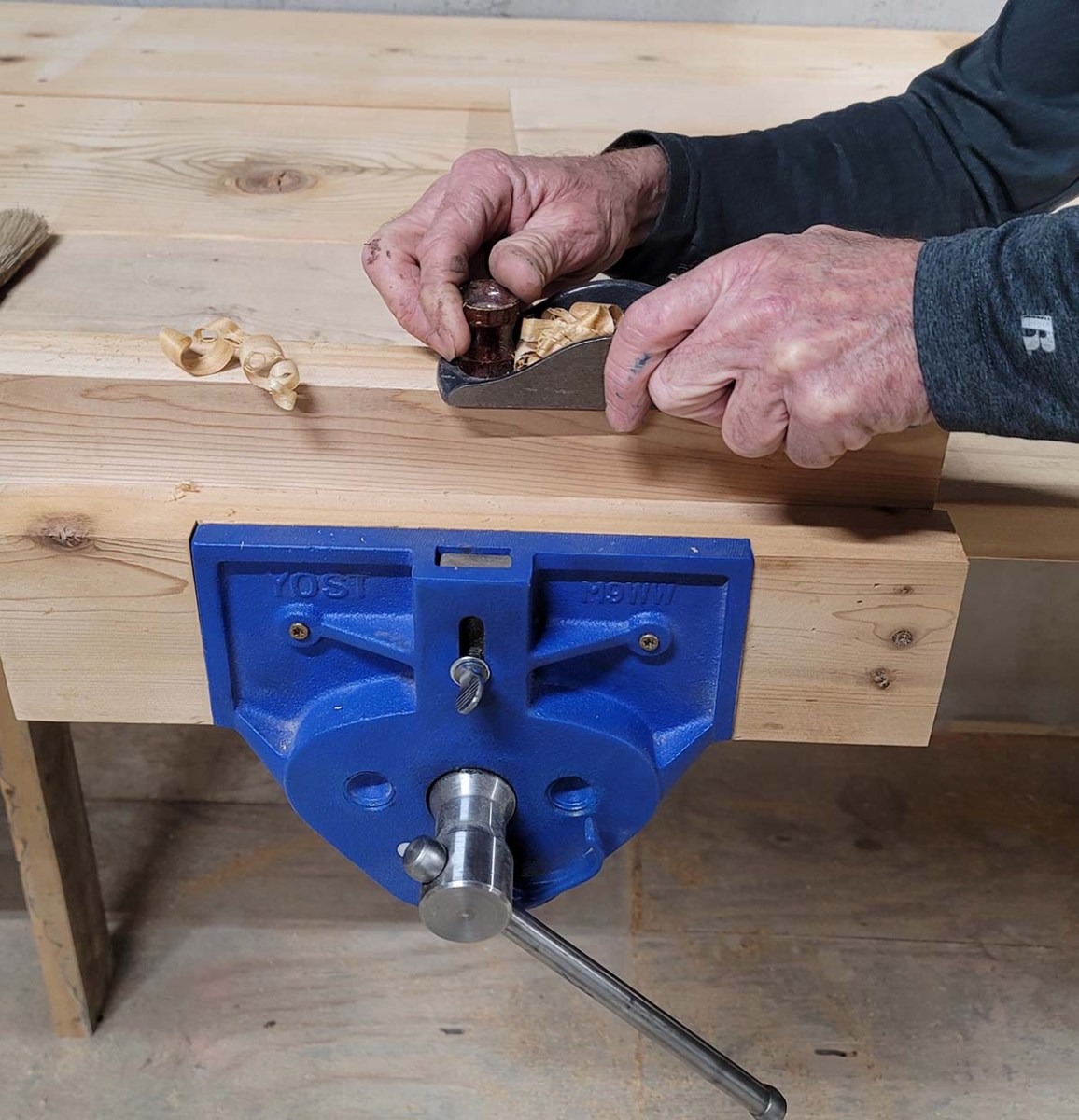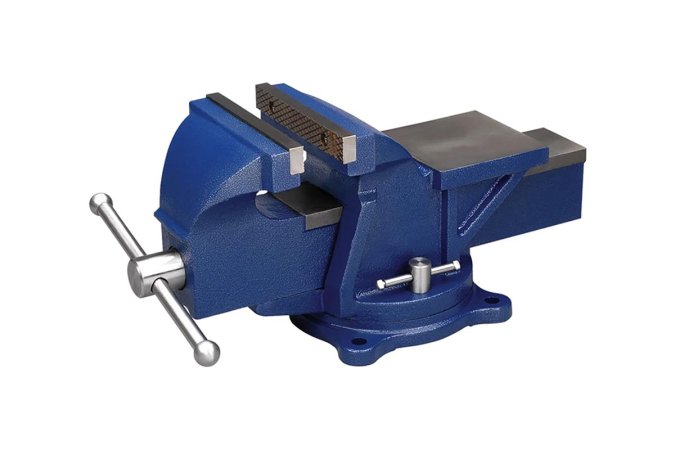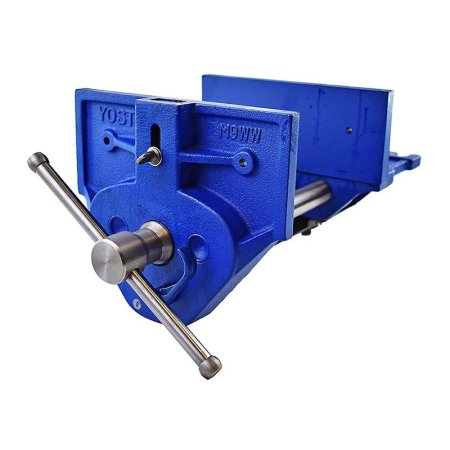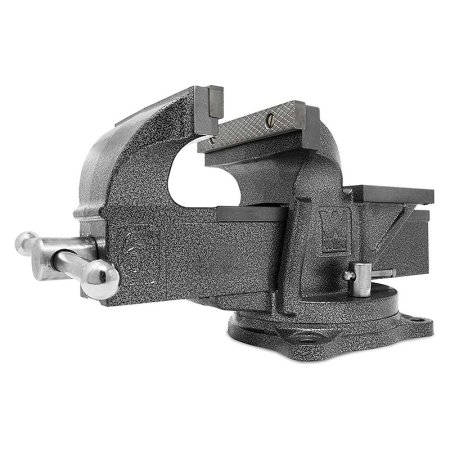The Best Bench Vises, Tested
You only have two hands—which can be a challenge with certain projects, such as when you still need to hold an item and yet require both hands to work on it. Indeed, there may also be times when using your hands to hold a workpiece simply isn’t feasible. The solution to these scenarios might just be a bench vise, a metal clamping device that bolts to a workbench.
Being enthusiastic DIYers, we were excited to test the top bench vises for ourselves—and determine which ones really offered the gripping power we needed. We decided to try them in our own workshop. We selected top-selling bench vises and mounted them to workbenches. We used them to grasp boards, pipes, and other items. We also tried out each of their features to determine how useful they would be for various projects, ranging from woodworking to mechanical uses to gunsmithing.
Ahead in this guide, DIYers looking to increase workshop functionality will learn about the different styles and features of the best bench vises. Plus, you’ll find out how the following models earned a spot in this lineup during our hands-on testing.
- BEST OVERALL:Wilton 11106 General Purpose 6-Inch Jaw Bench Vise
- BEST BANG FOR THE BUCK:Pony Jorgensen 27091 Woodworker’s Vise
- UPGRADE PICK:Wilton WS8 63304 Shop Vise
- BEST FOR WOODWORKING: Yost M9WW 9-Inch Rapid-Action Woodworking Vise
- BEST DIY SHOP VISE: Wen BV456 6-Inch Heavy-Duty Cast Iron Bench Vise
- BEST FOR HOBBYISTS:Real Avid Master Gun Vise With Torq-Lok

How We Tested the Best Bench Vises
Bench vises are essential workshop helpers, and putting together a list of the best models to test was no small task. First, we drew upon personal experience with woodworking, automotive repair, welding, and plumbing to determine the most important features of a bench vise. Then we selected models for testing from the brands we trust the most in the category. We gave some preference to reputable manufacturers, such as Wen and Wilton, but we also looked at lesser-known brands if they had high customer ratings.
For the actual testing, we mounted each vise to a workbench using our own bolts and nuts, which are typically not included with purchase because workbench thicknesses vary. We used lag bolts and carriage bolts, ranging from 5/16 to ⅜ inch in diameter, but other bolts would also be suitable, depending on where and how the vise is mounted.
Once mounted, we used the vises for gripping several common items, including boards, pipes, and other pieces to see how well they stabilized the items as we worked on them. We loosened stuck-on fittings with the help of wrenches, sharpened chainsaw blades, planed and routed wood, and used a power drill to drill holes in the items.
During the tests, each vise was awarded points based on a rubric. The better the product performed, the higher the points it received. After testing, we added and averaged each vise’s points and used those to help determine the most appropriate use and category.
| Testing Stats | |
| Products tests | 6 |
| Hours spend testing | 3 hours per vise |
| Tests performed | 3 |
| Price range | $70 to $300 |
Our Top Picks
The following bench vises range from woodworking options with quick-release functions to heavy-duty cast-iron mechanic models—and all excelled in our hands-on testing. The models vary in type, size, and primary purpose, but each stands out in its category. We detail the pros and cons of each so our readers can help determine which best suits their project needs before buying a bench vise. Unfortunately, not all the vises we tested earned a spot in this lineup. The one that didn’t meet our high standards can be found below under “Also Tested.”
BEST OVERALL
Wilton 11106 General Purpose 6-Inch Jaw Bench Vise

This Bob Vila Approved product carries our brand’s highest level of recommendation.

Bob Vila Approved recognizes the household and DIY products that impressed us most in our real-world testing and that exemplify core values of the Bob Vila brand, including craftsmanship, innovation, and value for the dollar. Winners of this designation come recommended by our professional review team and are personally approved by Bob Vila.
Our Ratings: Mounting 5/5; Ease of Use 5/5; Durability 5/5; Versatility 5/5
Product Specs
- Type: Benchtop
- Size: 6 inches (jaw width and jaw opening)
- Jaw material: Cast iron
What We Like
- Heavy-duty bench vise made from cast-iron bolts to a workbench for stability
- The flat anvil on the back is useful for hammering out small items
- Strong jaws keep steel pipes and other items from slipping
- Swivel bench vice capability for added versatility and user-friendliness
What We Don’t Like
- The corrugated faces on the jaws leave impressions in wood
Coming in as our top pick is the Wilton 6-inch bench vise— a formidable workshop tool. Like most bench vises, it comes fully assembled with a cast iron construction; all we had to do was mount it to the top of our workbench. This entailed marking the location of its four holes, drilling the holes, and then bolting it in place. Bolts were not included, which is standard, because the manufacturer doesn’t know how thick a user’s workbench will be.
We tested the handle-and-screw action of the vise by loosening and opening the jaws and then closing them again. The heavy-duty bench vise jaws moved smoothly and evenly—no sticking or hanging. We then loosened the lever for the swiveling mechanism, allowing us to swivel the vise’s upper portion and retighten the lever to lock it into position. It rotated smoothly to any angle we chose.
The Wilton bench vise has a 6-inch jaw width and strong gripping power—we tightened several items in its jaws, including pipes, iron bars, and wood. We could loosen stuck-on pipe fittings using a wrench without the pipe slipping in the jaws’ grip. We drilled holes in boards, and the Wilton vise held them securely—no slipping. We also used the anvil on the back to flatten a copper pipe with a hammer. The anvil is relatively small—about 4 inches by 4 inches—but it’s suitable for hammering small items.
The downside—and we expected this—was visible imprints in the wood from the corrugated jaws. We could get around this problem by positioning thin pieces of plywood between the board we were working on and the iron jaws on both sides, but woodworking is not the primary purpose for this heavy-duty bench vise. Instead, this is a general-use vise that can be used for multiple shop purposes, such as holding blades for sharpening and pipes to remove fittings. It can even serve to crack the occasional black walnut if desired—we did that, too!
Get the Wilton 11106 bench vise at Amazon, Lowe’s, or Toolup.com.
BEST BANG FOR THE BUCK:
Pony Jorgensen 27091 Woodworker's Vise

Our Ratings: Mounting 4/5; Ease of Use 3/5; Durability 4/5; Versatility 3/5
Product Specs
- Type: Face-mount
- Size: 8 inches (jaw opening); 7 inches wide
- Jaw material: Steel
What We Like
- Affordable steel vise with smooth jaws designed to protect wood from marring
- Adjustable dog for use with a bench stop to support wider boards
- Holes on inside jaw plates designed for attaching wood jaw liners (not included)
What We Don’t Like
- Smooth jaws make this vise unsuitable for gripping any pipes
- No quick-release lever—user must manually open and close the handle screw
Workshop warriors need not spend a fortune to get a reliable vise for woodworking projects. We mounted and tested the Pony Jorgenson woodworker’s vise and found it strong, durable, and versatile. This heavy-duty vise is designed to hold wood, as its smooth inner jaws are less likely to mar boards when gripping them tightly. Screw holes on the inner sides of the jaws are suitable for attaching wood jaw liners, which is something many woodworkers do for extra insurance against marring when working with delicate wood species, such as cedar or poplar. The Pony vise mounts to both the front and the underside of a workbench—which is typical for face-type vises used in woodworking.
The vise comes with a dog: a bar that can be extended upward on the front of the vise to stabilize larger boards. Dogs are relatively common on wood vises, and we really liked how smoothly this one pushed up and down and how well it held our boards. A dog is used in combination with a bench stop on the top of a workbench.
To create a stop, we attached a wood block to the top of the workbench about 12 inches from the vise. We opened the vise, raised the dog, and positioned a 14-inch-wide board between the dog and the bench stop. We tightened the vise’s handle screw until the board was snugly wedged between the bench stop and the dog. We could then sand and rout the board’s edges while the dog held the board firmly in place.
A slight downside to the Pony Jorgenson vise is the lack of a quick-release or quick-adjustment lever: We had to open and close the vise jaws using only the handle screw. Still, at this price, that’s not a deal breaker. This is a medium-duty vise, meaning it will handle most wood-gripping needs, but it’s made from steel rather than cast iron, so it isn’t designed to withstand heavy use, such as holding heavy timbers for notching.
Get the Pony Jorgensen bench vise at Amazon, KMS Tools, or Shop Abunda.
UPGRADE PICK
Wilton WS8 63304 Shop Vise

Our Ratings: Mounting 3/5; Ease of Use 5/5; Durability 4/5; Versatility 4/5
Product Specs
- Type: Benchtop
- Size: 8 inches (jaw width and jaw opening)
- Jaw material: Cast iron
What We Like
- Heavy-duty design makes for a beefy vise with a lot of gripping power
- The 8-inch jaw opening can handle larger items than many competitors
- Swivel bench vise capability; base allows users to turn the vise in any direction while working
What We Don’t Like
- Vise must be mounted on a very sturdy workbench due to weight (65.3 pounds)
Here come the big boys! The first thing we noticed was how heavy the Wilton heavy-duty bench vise is: an impressive 65.3 pounds, making it the beefiest vise we tested. Be sure to mount it on a sturdy workbench—over a bench leg, if possible, which will help bear its weight.
This shop-type vise is well suited for those who do plumbing or metal fabrication and need a strong vise for holding steel or iron items with it’s 8-inch jaw width and cast iron construction. We mounted the vise to the top of our workbench and tested its gripping power. We used it to secure pipes while we removed stuck-on fittings with a wrench, and the pipes didn’t slip even though we applied a lot of twisting pressure. This large cast-iron vise also firmly held iron rebar as we filed it. We loosened the swivel lever and turned the upper part of the vise in various directions, a handy feature that allowed us to work comfortably—no need to lean or strain.
We also hammered the end of a copper pipe flat on the anvil on the back of the vise. The serrated jaws are replaceable, but throughout our testing, which included cranking down tightly on multiple iron and steel items, they survived with only a couple of surface scratches, so we think they will last a long time before needing to be replaced.
This isn’t a vise for woodworking, however. Its serrated jaws are too rough to hold wood without leaving imprints, as we discovered when we used the vise to grip a board as we routed the edge. This vise is best suited to holding steel and iron items, which it does very well.
Get the Wilton WS8 bench vise at Amazon, The Home Depot, or Fastenal.
BEST FOR WOODWORKING
Yost M9WW 9-Inch Rapid-Action Woodworking Vise

Our Ratings: Mounting 3/5; Ease of Use 3/5; Durability 3/5; Versatility 2/5
Product Specs
- Type: Face mount
- Size: 9 inches (jaw plate width); 10.25 inches (jaw opening)
- Jaw material: Cast iron
What We Like
- Wider-than-average jaw opening (10.25 inches) allows for use with large boards
- Adjustable dog for use with a bench stop (not included) increases the size of the boards the vise will hold
- Quick-adjustment lever allows the user to move the plate into position and then tweak the grip with the handle
- Holes provided for attaching fabricated wood jaw liners
What We Don’t Like
- Smooth jaws not designed for holding pipes, steel, or iron items
With smooth inner jaws and a 10.25-inch jaw width, the Yost woodworking vise securely holds large wood projects without marring the workpiece. We mounted this face-mount vise to the front of our workbench, where most woodworking vises are made to install.
The vise has holes on the inner jaws designed to attach custom wood jaw liners, so we fabricated two wood liners to fit the jaws. That involved routing out sections on two boards to match the size of the jaw plates and then attaching the boards to the inner jaws via screws. This gave us a larger gripping area for holding boards without the risk of marring the wood. Most professional woodworkers will fabricate their own liners for this reason, but the jaws themselves are smooth enough to support many wood projects without damage.
The Yost also comes with an adjustable dog on the front jaw plate that we used in conjunction with a bench stop for holding wider boards securely as we sanded, planed, and routed. We didn’t experience any slipping.
One of the nicest things about the Yost vise is its quick-adjust lever that allowed us to move the outer jaw in or out quickly. This was a big time saver, as we could move the jaw to fit the board size and then use the handle to increase the gripping pressure.
Read our full review: Yost M9WW 9-Inch Rapid-Action Woodworking Vise
Get the Yost bench vise atAmazon, The Home Depot,or Eastwood.
BEST DIY SHOP VISE
Wen BV456 6-Inch Heavy-Duty Cast Iron Bench Vise

Our Ratings: Mounting 4/5; Ease of Use 4/5; Durability 4/5; Versatility 3/5
Product Specs
- Type: Benchtop
- Size: 6 inches (jaw width); 6⅜ inches (jaw opening)
- Jaw material: Cast iron
What We Like
- Heavy-duty cast-iron construction for durability and gripping power
- Swivel bench vise capability; swivel base is suitable for turning it in the most advantageous direction
- Strong serrated jaws hold items snugly without slipping for most shop tasks
What We Don’t Like
- Not suitable for holding wood projects as the jaws leave imprints in wood
We found the Wen 6-inch top-mounted vise to be just the right size for a mechanic’s garage workshop or other DIY users. It’s not as big as the oversize Wilton model we tested, but it’s large enough to tackle most pipe- and steel-gripping needs. We mounted the Wen vise to the top of our workbench and tested its gripping strength. It held bars firmly while we twisted off stuck-on fittings and gripped steel railings as we filed and cut through them. We even used it to hold a chainsaw while sharpening its blade. The swivel base made it easy to